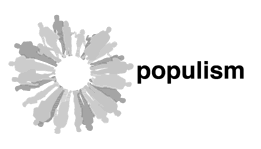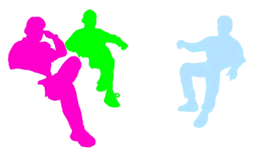Henrik Plenge Jakobsen
Everything is Wrong is the clear message of one of Henrik Plenge Jakobsen’s older works – a multi coloured target painting with a text written over it. Just as clear is the statement J’Accuse, the title of one of his latest projects, which starts out from Emile Zola’s famous indictment from 1898 to the French president on occasion of the Dreyfuss affair. It is a large black and white total installation, which leads the spectator into a scene that on the surface seems simple – black on white – but is filled with absurd references, futuristic elements (a pair of freaky speakers with over-sized horns à la early Marinetti), and visual word play, which make it difficult to discover the actual state of affairs. This is similar to the political climate of today, where fear, suspicion and calculated political spin make it difficult to present the truth in other than grey-scale.
Both Everything is Wrong and J’Accuse are characteristic of Plenge Jakobsen’s way of working. He moves on the border between a very direct, pop-political attitude, and an expression that draws on more poetic and complex connections. This is also the case in his latest work, Circus Pentium, where he utilises one of the archetypes of the entertainment industry, the circus. Circus Pentium is partly a concrete installation with trapezes, a circus tent and arena – but it is also a dissolving circus. The Wheel of Lost Fortunes has run amok and turns round and round without ever stopping. The black, rhomboid mirrors in the dressing room, Satan Mirrors, have razor-sharp edges and colourful light bulbs. Wallpaper with a violent op-art pattern adds to the dystopian feeling of a circus run amok.
The circus-installation is accompanied by the libretto for an absurd opera written by the artist himself. The story is about a circus troupe on tour, which ends up attacking the mean impresario, who has exploited them all. The circus troupe is a mixed group, which in addition to a circus princess, a Bengal tiger and twin acrobats, also includes one of Freud’s hysteric patients, Frau Emmy von N and the first critic of the mass seduction of the culture industry, Theodor W. Adorno, who both performs as an ambitious bank man, the Citi-Group employee, and as a German intellectual, Theodor Wiesengrund. He is caught in a dilemma between capital and critical thought – just like a lot of artists in the contemporary international art arena. It is the eternal schism between lackey and critical thinker.
Circus Pentium is on the whole a delerious phantom of Western culture’s relation to power, thought, capital and psychoanalysis – united in the machinery through which our entire reality is constantly being treated and worked over – the ever-present digital processor, Pentium.
By Pernille Albrethsen, translated by Eva May.
"Circus Portikus" (2003) (Installation view Portikus, Frankfurt am Main) Courtesy the artsist and Galleri Nicolai Wallner, Copenhagen. Photo: Wolfgang Günzel
|









